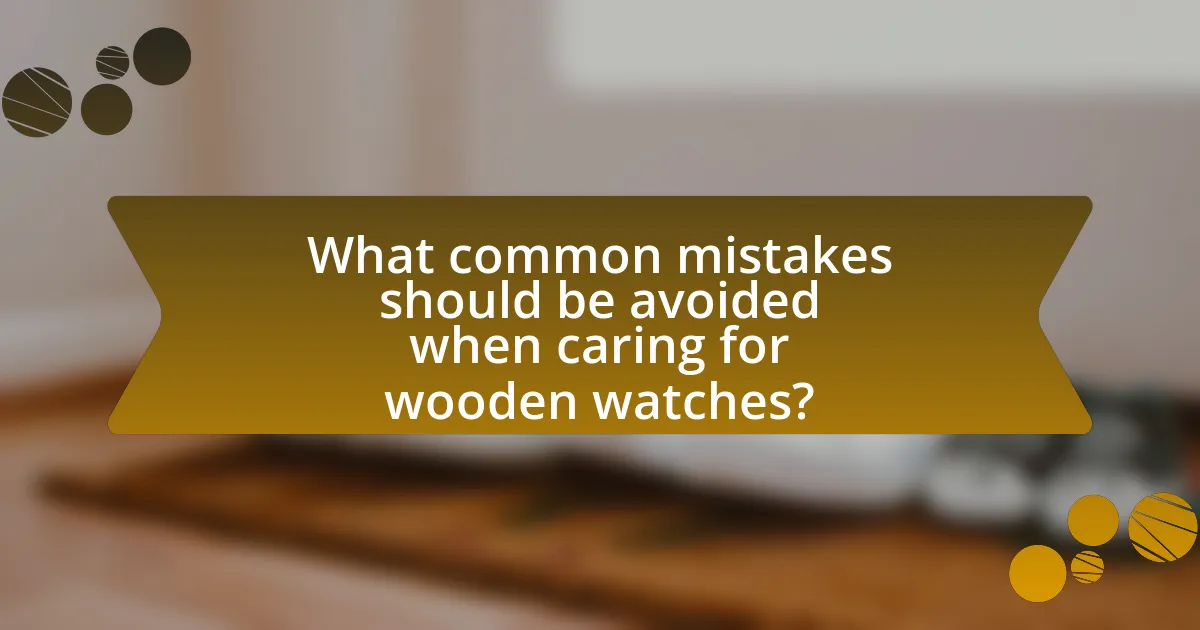The article focuses on essential tips for maintaining the quality of wooden watches over time. Key factors include proper cleaning techniques, humidity control, and regular maintenance practices to prevent damage from environmental exposure. It emphasizes the importance of avoiding extreme temperatures and direct sunlight, as well as the necessity of periodic oiling to preserve the wood’s integrity. Additionally, the article outlines best storage practices and identifies signs that indicate a wooden watch may require professional maintenance, ensuring that readers are equipped with practical knowledge to extend the lifespan of their wooden timepieces.

What are the key factors in maintaining the quality of wooden watches over time?
The key factors in maintaining the quality of wooden watches over time include proper cleaning, humidity control, and regular maintenance. Proper cleaning involves using a soft, dry cloth to remove dust and moisture, preventing damage to the wood. Humidity control is crucial, as excessive moisture can lead to warping or mold growth; maintaining a stable environment with a relative humidity of around 40-60% is recommended. Regular maintenance, such as checking the watch’s movement and ensuring the wood is treated with appropriate oils or waxes, helps preserve its appearance and functionality. These practices are supported by industry standards that emphasize the importance of environmental conditions and care in prolonging the lifespan of wooden timepieces.
How does environmental exposure affect wooden watches?
Environmental exposure significantly affects wooden watches by causing changes in their structural integrity and appearance. Factors such as humidity, temperature fluctuations, and exposure to sunlight can lead to warping, cracking, or fading of the wood. For instance, high humidity can cause the wood to swell, while low humidity can lead to shrinkage, both of which compromise the watch’s durability. Additionally, prolonged exposure to UV light can result in discoloration and degradation of the wood finish. These effects underscore the importance of proper care and maintenance to preserve the quality and longevity of wooden watches.
What specific environmental conditions should be avoided?
Wooden watches should be kept away from high humidity, extreme temperatures, and direct sunlight. High humidity can cause wood to swell and warp, while extreme temperatures can lead to cracking or splitting. Direct sunlight can fade the wood’s color and damage the finish. These conditions compromise the integrity and appearance of wooden watches, leading to a shorter lifespan.
How can humidity levels impact the wood quality?
Humidity levels significantly impact wood quality by influencing its moisture content, which can lead to warping, cracking, or swelling. When humidity is high, wood absorbs moisture, causing it to expand and potentially distort its shape. Conversely, low humidity levels can lead to the wood losing moisture, resulting in shrinkage and the formation of cracks. Research indicates that maintaining a relative humidity level between 30% and 50% is optimal for preserving the structural integrity and appearance of wood, as deviations from this range can compromise its durability and aesthetic qualities.
What maintenance practices are essential for wooden watches?
Essential maintenance practices for wooden watches include regular cleaning, proper storage, and periodic oiling. Cleaning involves using a soft, dry cloth to remove dust and moisture, preventing damage to the wood. Proper storage requires keeping the watch in a cool, dry place away from direct sunlight and humidity, which can warp the wood. Periodic oiling with a suitable wood conditioner helps maintain the wood’s luster and prevents it from drying out or cracking. These practices ensure the longevity and aesthetic appeal of wooden watches.
How often should wooden watches be cleaned?
Wooden watches should be cleaned every 1 to 3 months, depending on usage and exposure to moisture. Regular cleaning helps maintain the wood’s appearance and prevents damage from dirt and oils. For instance, watches worn daily may require more frequent cleaning compared to those worn occasionally.
What cleaning materials are safe for wooden watches?
Cleaning materials that are safe for wooden watches include a soft, lint-free cloth, mild soap mixed with water, and natural oils like jojoba or mineral oil. The soft cloth effectively removes dust and fingerprints without scratching the wood. A mixture of mild soap and water can be used for deeper cleaning, ensuring that the soap is gentle to avoid damaging the finish. Natural oils help maintain the wood’s luster and protect it from moisture. These materials are recommended because they do not contain harsh chemicals that could harm the wood or its finish.
Why is regular oiling important for wooden watches?
Regular oiling is important for wooden watches because it prevents the wood from drying out and cracking. Wood is a natural material that can lose moisture over time, leading to deterioration. By applying oil, the wood retains its natural oils, enhancing its durability and appearance. Additionally, regular oiling helps protect against environmental factors such as humidity and temperature changes, which can further affect the integrity of the wood. This maintenance practice is essential for preserving the longevity and aesthetic quality of wooden watches.
What types of oils are recommended for wooden watches?
The types of oils recommended for wooden watches include mineral oil, tung oil, and linseed oil. Mineral oil is commonly used due to its ability to penetrate wood and provide moisture without altering the wood’s natural appearance. Tung oil is favored for its water-resistant properties and ability to enhance the wood’s grain, while linseed oil is known for its protective qualities and ease of application. These oils help maintain the quality of wooden watches by preventing drying and cracking, ensuring longevity and aesthetic appeal.
How can improper oiling affect the watch’s longevity?
Improper oiling can significantly reduce a watch’s longevity by causing increased friction and wear on its moving parts. When a watch is not adequately oiled, the lubricants can dry out or become contaminated, leading to insufficient lubrication. This lack of proper lubrication results in metal components grinding against each other, which accelerates wear and can lead to mechanical failure. Studies show that regular maintenance, including proper oiling, can extend the lifespan of a watch by preventing these issues, highlighting the importance of correct oil application in watch care.

What common mistakes should be avoided when caring for wooden watches?
Common mistakes to avoid when caring for wooden watches include exposing them to excessive moisture, direct sunlight, and extreme temperatures. Wooden watches are sensitive to humidity, which can cause warping or damage to the wood. For instance, wearing a wooden watch while swimming or in a sauna can lead to irreversible damage. Additionally, prolonged exposure to sunlight can fade the wood’s color and finish, while extreme temperatures can cause the wood to crack. Proper storage in a cool, dry place and using a protective case can help maintain the watch’s integrity.
How can exposure to water damage wooden watches?
Exposure to water can damage wooden watches by causing the wood to swell, warp, or crack. When wood absorbs moisture, it expands, which can lead to structural integrity issues and misalignment of watch components. Additionally, prolonged exposure to water can promote mold and mildew growth, further deteriorating the watch’s condition. The porous nature of wood makes it susceptible to these effects, as evidenced by studies showing that untreated wood can absorb significant amounts of water, leading to irreversible damage over time.
What steps can be taken to protect wooden watches from water?
To protect wooden watches from water, apply a waterproofing sealant specifically designed for wood. This sealant creates a barrier that prevents moisture from penetrating the wood, thereby reducing the risk of warping or damage. Regularly reapply the sealant according to the manufacturer’s instructions, typically every six months to a year, to maintain its effectiveness. Additionally, avoid exposing the watch to water by removing it before activities such as swimming or showering, as prolonged exposure can compromise the wood’s integrity.
What should be done if a wooden watch gets wet?
If a wooden watch gets wet, it should be dried immediately to prevent damage. The watch should be gently wiped with a soft, dry cloth to remove excess moisture, and then left in a dry, well-ventilated area to air dry completely. Prolonged exposure to water can cause the wood to warp or crack, so prompt action is essential to maintain the watch’s integrity.
Why is it important to avoid extreme temperatures for wooden watches?
Avoiding extreme temperatures is crucial for wooden watches because such conditions can lead to warping, cracking, or splitting of the wood. Wood is a natural material that expands and contracts with temperature fluctuations; excessive heat can dry out the wood, while extreme cold can make it brittle. Research indicates that maintaining a stable environment helps preserve the integrity and longevity of wooden products, including watches. Therefore, protecting wooden watches from extreme temperatures ensures their durability and aesthetic appeal over time.
What temperature ranges are considered safe for wooden watches?
Safe temperature ranges for wooden watches are typically between 32°F to 120°F (0°C to 49°C). Exposure to temperatures outside this range can lead to warping, cracking, or other damage to the wood. Maintaining wooden watches within these specified temperatures helps preserve their structural integrity and aesthetic appearance.
How can extreme temperatures lead to wood warping or cracking?
Extreme temperatures can lead to wood warping or cracking due to the expansion and contraction of wood fibers. When exposed to high temperatures, wood absorbs heat, causing it to expand; conversely, low temperatures can cause it to contract. This cycle of expansion and contraction can create internal stresses within the wood, leading to warping or cracking. Research indicates that wood moisture content plays a critical role, as wood with higher moisture content is more susceptible to these changes. For instance, a study published in the “Journal of Wood Science” found that wood subjected to rapid temperature fluctuations experienced significant dimensional changes, confirming that extreme temperatures directly impact wood integrity.

What are the best practices for storing wooden watches?
The best practices for storing wooden watches include keeping them in a cool, dry place away from direct sunlight and humidity. Wooden watches are sensitive to temperature and moisture, which can cause warping or cracking. Using a dedicated watch box or a soft cloth pouch can provide protection from dust and scratches. Additionally, it is advisable to avoid storing wooden watches near heat sources, as excessive heat can damage the wood finish. Regularly checking the condition of the watch while in storage ensures that any potential issues are addressed promptly.
How should wooden watches be stored when not in use?
Wooden watches should be stored in a cool, dry place away from direct sunlight when not in use. This storage method prevents warping, cracking, and fading of the wood, which can occur due to temperature fluctuations and moisture exposure. Additionally, using a soft cloth or a dedicated watch box can help protect the watch from dust and scratches, further preserving its quality over time.
What types of storage solutions are ideal for wooden watches?
Ideal storage solutions for wooden watches include wooden watch boxes, soft pouches, and climate-controlled display cases. Wooden watch boxes provide a protective environment that minimizes exposure to moisture and temperature fluctuations, which can damage the wood. Soft pouches offer a lightweight and portable option, protecting the watch from scratches and dust. Climate-controlled display cases maintain optimal humidity and temperature levels, preventing warping or cracking of the wood. These storage methods ensure the longevity and aesthetic appeal of wooden watches by safeguarding them from environmental factors.
How can proper storage extend the life of a wooden watch?
Proper storage can significantly extend the life of a wooden watch by protecting it from environmental factors that can cause damage. Storing a wooden watch in a cool, dry place prevents exposure to excessive humidity, which can lead to warping or mold growth. Additionally, keeping the watch away from direct sunlight minimizes the risk of fading and cracking in the wood. Using a soft cloth or a dedicated watch box can further shield the watch from scratches and impacts. These practices help maintain the integrity of the wood and the watch’s overall functionality, ensuring it remains in optimal condition for years.
What are the signs that a wooden watch needs professional maintenance?
A wooden watch needs professional maintenance when it shows signs of wear, such as cracks in the wood, difficulty in adjusting the time, or a malfunctioning movement. Cracks indicate that the wood may be drying out or has been exposed to moisture, which can compromise its integrity. Difficulty in adjusting the time suggests that the internal mechanisms may be jammed or damaged, requiring expert attention. A malfunctioning movement can lead to inaccurate timekeeping, signaling that the watch needs servicing to restore its functionality. Regular checks for these signs can help maintain the quality and longevity of wooden watches.
How can one identify wear and tear on a wooden watch?
To identify wear and tear on a wooden watch, examine the watch for visible scratches, dents, or discoloration on the wood surface. These signs indicate that the wood has been subjected to physical stress or environmental factors. Additionally, check for loose components or changes in the watch’s functionality, such as difficulty in adjusting the time or a malfunctioning clasp. Regular inspection of the watch can help detect these issues early, allowing for timely maintenance or repairs.
What should be done if a wooden watch shows signs of damage?
If a wooden watch shows signs of damage, it should be assessed for the type and extent of the damage. Minor scratches can often be polished out using a soft cloth and wood polish, while deeper cracks may require professional repair or replacement of the damaged part. Regular maintenance, such as applying a wood conditioner, can help prevent further damage. Proper care and timely intervention are essential to prolong the lifespan of the wooden watch.
What practical tips can help maintain the quality of wooden watches over time?
To maintain the quality of wooden watches over time, regularly clean the watch with a soft, dry cloth to remove dust and moisture. This practice prevents buildup that can damage the wood and finish. Additionally, avoid exposing the watch to extreme temperatures and humidity, as these conditions can warp the wood and affect its integrity. Applying a wood conditioner periodically can also help preserve the wood’s natural oils and prevent drying or cracking. Lastly, store the watch in a cool, dry place when not in use to protect it from environmental factors that could degrade its quality.
